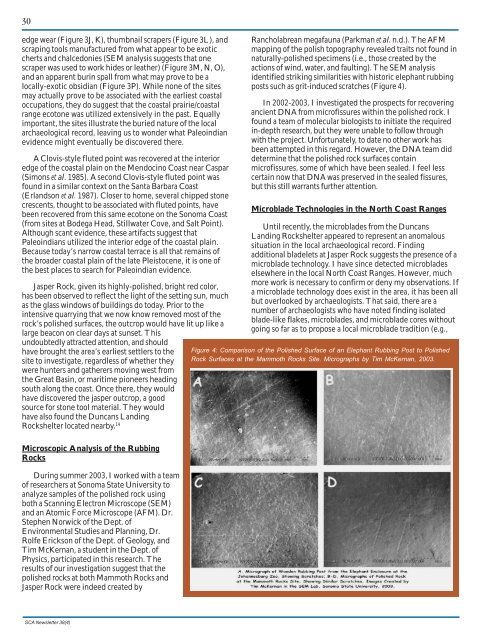Mammoth Rub Update - Society for California Archaeology
Mammoth Rub Update - Society for California Archaeology
Mammoth Rub Update - Society for California Archaeology
You also want an ePaper? Increase the reach of your titles
YUMPU automatically turns print PDFs into web optimized ePapers that Google loves.
30<br />
edge wear (Figure 3J, K), thumbnail scrapers (Figure 3L), and<br />
scraping tools manufactured from what appear to be exotic<br />
cherts and chalcedonies (SEM analysis suggests that one<br />
scraper was used to work hides or leather) (Figure 3M, N, O),<br />
and an apparent burin spall from what may prove to be a<br />
locally-exotic obsidian (Figure 3P). While none of the sites<br />
may actually prove to be associated with the earliest coastal<br />
occupations, they do suggest that the coastal prairie/coastal<br />
range ecotone was utilized extensively in the past. Equally<br />
important, the sites illustrate the buried nature of the local<br />
archaeological record, leaving us to wonder what Paleoindian<br />
evidence might eventually be discovered there.<br />
A Clovis-style fluted point was recovered at the interior<br />
edge of the coastal plain on the Mendocino Coast near Caspar<br />
(Simons et al. 1985). A second Clovis-style fluted point was<br />
found in a similar context on the Santa Barbara Coast<br />
(Erlandson et al. 1987). Closer to home, several chipped stone<br />
crescents, thought to be associated with fluted points, have<br />
been recovered from this same ecotone on the Sonoma Coast<br />
(from sites at Bodega Head, Stillwater Cove, and Salt Point).<br />
Although scant evidence, these artifacts suggest that<br />
Paleoindians utilized the interior edge of the coastal plain.<br />
Because today’s narrow coastal terrace is all that remains of<br />
the broader coastal plain of the late Pleistocene, it is one of<br />
the best places to search <strong>for</strong> Paleoindian evidence.<br />
Jasper Rock, given its highly-polished, bright red color,<br />
has been observed to reflect the light of the setting sun, much<br />
as the glass windows of buildings do today. Prior to the<br />
intensive quarrying that we now know removed most of the<br />
rock’s polished surfaces, the outcrop would have lit up like a<br />
large beacon on clear days at sunset. This<br />
undoubtedly attracted attention, and should<br />
have brought the area’s earliest settlers to the<br />
site to investigate, regardless of whether they<br />
were hunters and gatherers moving west from<br />
the Great Basin, or maritime pioneers heading<br />
south along the coast. Once there, they would<br />
have discovered the jasper outcrop, a good<br />
source <strong>for</strong> stone tool material. They would<br />
have also found the Duncans Landing<br />
Rockshelter located nearby. 14<br />
Microscopic Analysis of the <strong>Rub</strong>bing<br />
Rocks<br />
During summer 2003, I worked with a team<br />
of researchers at Sonoma State University to<br />
analyze samples of the polished rock using<br />
both a Scanning Electron Microscope (SEM)<br />
and an Atomic Force Microscope (AFM). Dr.<br />
Stephen Norwick of the Dept. of<br />
Environmental Studies and Planning, Dr.<br />
Rolfe Erickson of the Dept. of Geology, and<br />
Tim McKernan, a student in the Dept. of<br />
Physics, participated in this research. The<br />
results of our investigation suggest that the<br />
polished rocks at both <strong>Mammoth</strong> Rocks and<br />
Jasper Rock were indeed created by<br />
SCA Newsletter 38(4)<br />
Rancholabrean megafauna (Parkman et al. n.d.). The AFM<br />
mapping of the polish topography revealed traits not found in<br />
naturally-polished specimens (i.e., those created by the<br />
actions of wind, water, and faulting). The SEM analysis<br />
identified striking similarities with historic elephant rubbing<br />
posts such as grit-induced scratches (Figure 4).<br />
In 2002-2003, I investigated the prospects <strong>for</strong> recovering<br />
ancient DNA from microfissures within the polished rock. I<br />
found a team of molecular biologists to initiate the required<br />
in-depth research, but they were unable to follow through<br />
with the project. Un<strong>for</strong>tunately, to date no other work has<br />
been attempted in this regard. However, the DNA team did<br />
determine that the polished rock surfaces contain<br />
microfissures, some of which have been sealed. I feel less<br />
certain now that DNA was preserved in the sealed fissures,<br />
but this still warrants further attention.<br />
Microblade Technologies in the North Coast Ranges<br />
Until recently, the microblades from the Duncans<br />
Landing Rockshelter appeared to represent an anomalous<br />
situation in the local archaeological record. Finding<br />
additional bladelets at Jasper Rock suggests the presence of a<br />
microblade technology. I have since detected microblades<br />
elsewhere in the local North Coast Ranges. However, much<br />
more work is necessary to confirm or deny my observations. If<br />
a microblade technology does exist in the area, it has been all<br />
but overlooked by archaeologists. That said, there are a<br />
number of archaeologists who have noted finding isolated<br />
blade-like flakes, microblades, and microblade cores without<br />
going so far as to propose a local microblade tradition (e.g.,<br />
Figure 4: Comparison of the Polished Surface of an Elephant <strong>Rub</strong>bing Post to Polished<br />
Rock Surfaces at the <strong>Mammoth</strong> Rocks Site. Micrographs by Tim McKernan, 2003.

















